Welcome to the addition worksheets page at Math-Drills.com where we will add to your learning experience in many positive ways! On this page, you will find Addition worksheets from addition facts and two-digit addition to column addition and addition with games. In the first section, we've included a few addition printables that should help out the beginning student. Teaching addition facts is best done with some interesting teaching strategies.
Some teachers and parents use addition manipulatives to help students understand the basic addition facts. For example, adding groups of "Apple Jacks" (a breakfast cereal) by counting will quickly lead students to understand the concepts of addition. The sooner you can introduce base ten blocks to your students, the better. If you haven't already used them for counting, use them for basic addition and show students how regrouping works.
Most Popular Addition Worksheets this Week
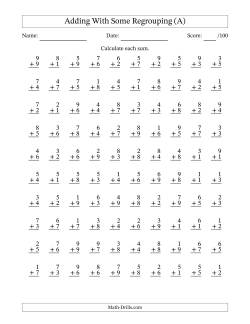
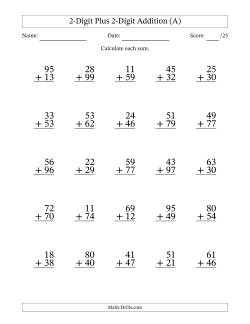
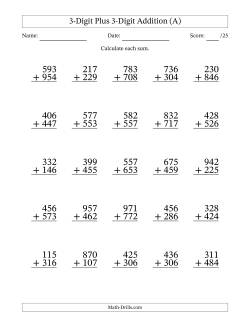
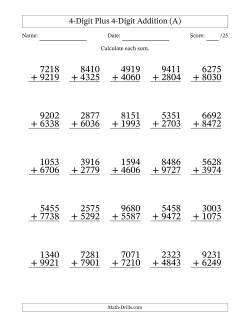
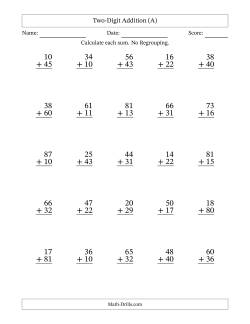
Addition Facts Tables
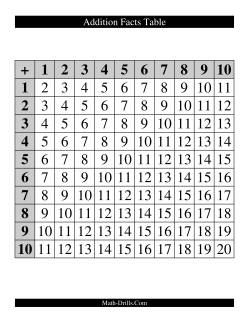
Disputably not a great way to learn addition facts, but undeniably a great way to summarize, addition facts tables are an invaluable resource in any home or school classroom. Addition works very well as a table since the addends can be sequential. Encourage students to look for patterns and teach them a variety of strategies to learn the addition facts. For students who have not yet memorized their addition facts but need to know them for a more advanced math lesson such as adding two-digit numbers, provide an addition facts table to them, so they can quickly look up addition facts. After a while, they will most likely learn the facts through the use of the table and become less reliant on it. To make the tables more durable, print them on card stock and laminate them. They can be displayed on a screen or enlarged and printed on poster paper for whole class use.
-
Addition Facts Table 1 to 10 (Filled In) Addition Facts Table 1 to 10 (Blank) Addition Facts Table 0 to 9 (Filled In) Addition Facts Table 0 to 9 (Blank) Left-Handed Addition Facts Table Left-Handed Blank Addition Facts Table All Addition Facts Tables Addition Facts Tables With One Fact at a time highlighted
Five Minute Addition Frenzies
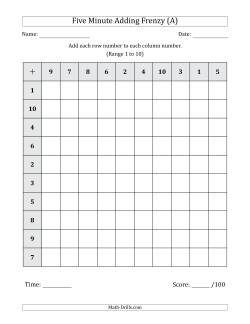
Five minute frenzy charts are 10 by 10 grids for addition fact practice. In each square, students write the sum of the column number and the row number.
Called mad minutes or timed drills by some, five minute frenzies are meant to be timed to add a little more excitement to practicing addition facts. They are ideally used to increase a student's ability to recall addition facts quickly which has all sorts of benefits later in their school life including preventing high school teachers from complaining about "how their students can't even add single-digit numbers without using a calculator."
A general goal to achieve would be to complete one chart in less than five minutes and score 98 percent or better, however, we recommend setting personal goals for students based on an initial test. If they are banging their head against the wall after a couple of minutes with only a few questions done, they really shouldn't be completing a timed addition facts drill at the moment. They still have some learning to do. We would recommend breaking out the manipulatives at this point. If they blast through the questions in 1.5 minutes and get almost all of them correct, they are probably ready for something a little more challenging.
One-per-page addition frenzies are not the most efficient use of paper resources, but they are a good starting point especially for younger students who have not quite mastered their penmanship enough to fit their numbers into a smaller chart. They are also great for displaying on screens or monitors for group activities. For example, you might use an interactive white board to fill out the chart.
A wiser use of paper and photo-copy limits, having four charts on a page allows for multi-day practice, collaborative work or through the use of a paper-cutter, a quick stack of practice pages for students who finish early.
Single-Digit Addition
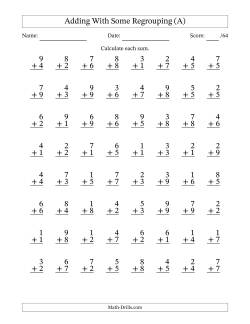
Most people would agree that being able to add single-digit numbers quickly and in your head is an essential skill for success in math. The various addition worksheets in this section focus on skills that students will use their entire life. These worksheets will not magically make a student learn addition, but they are valuable for reinforcement and practice and can also be used as assessment tools.
-
100 Single-Digit Addition Questions with Some Regrouping ✎ 81 Single-Digit Addition Questions with Some Regrouping ✎ 64 Single-Digit Addition Questions with Some Regrouping ✎ 50 Single-Digit Addition Questions with Some Regrouping ✎ 25 Single-Digit Addition Questions with Some Regrouping ✎ 12 Single-Digit Addition Questions with Some Regrouping ✎
-
Horizontally Arranged Single-Digit Addition Facts (100 Questions) ✎ Horizontally Arranged Single-Digit Addition Facts (50 Questions) ✎ Horizontal Numbers that Add to 10 Horizontally Arranged Single-Digit Addition Facts up to 5 + 5 (100 Questions) ✎ Horizontally Arranged Single-Digit Addition Facts up to 6 + 6 (100 Questions) ✎ Horizontally Arranged Single-Digit Addition Facts up to 7 + 7 (100 Questions) ✎ Horizontally Arranged Single-Digit Addition Facts up to 8 + 8 (100 Questions) ✎
The make ten addition strategy involves "spliting" the second addend into two parts. The first part combines with the first addend to make ten and the second part is the leftover amount. The strategy helps students quickly add amounts over ten in their head. For example, adding 8 + 7, students first recognize that they need to add 2 to 8 to get 10, so they split the 7 into 2 + 5. The 8 + 2 makes 10 and 5 more makes 15. The skill can be extended to many situations, for example adding 24 + 9, students recognize that they need 6 more to get to 30 and 9 can be split into 6 + 3, so 24 + 6 = 30 and 3 more makes 33. Continuing on, students can work on recognizing "complements" of other important numbers (see section further down) to develop this strategy further.
-
Make 10 Addition Strategy Make 10 Addition Strategy Blanks Make 20 Addition Strategy Make 30 Addition Strategy Make 40 Addition Strategy Make 50 Addition Strategy Make 60 Addition Strategy Make 70 Addition Strategy Make 80 Addition Strategy Make 90 Addition Strategy Make Multiples of 10 Addition Strategy
Focusing on one number at a time is necessary for some students. Maybe they get overwhelmed with too much information and need to experience success in small steps.
-
Adding 0 to Single-Digit Numbers (50 Questions) ✎ Adding 1 to Single-Digit Numbers (50 Questions) ✎ Adding 2 to Single-Digit Numbers (50 Questions) ✎ Adding 1 or 2 to Single-Digit Numbers (50 Questions) ✎ Adding 3 to Single-Digit Numbers (50 Questions) ✎ Adding 4 to Single-Digit Numbers (50 Questions) ✎ Adding 5 to Single-Digit Numbers (50 Questions) ✎ Adding 6 to Single-Digit Numbers (50 Questions) ✎ Adding 7 to Single-Digit Numbers (50 Questions) ✎ Adding 8 to Single-Digit Numbers (50 Questions) ✎ Adding 9 to Single-Digit Numbers (50 Questions) ✎
-
Adding 0 to Single-Digit Numbers (25 Large Print Questions) ✎ Adding 1 to Single-Digit Numbers (25 Large Print Questions) ✎ Adding 2 to Single-Digit Numbers (25 Large Print Questions) ✎ Adding 3 to Single-Digit Numbers (25 Large Print Questions) ✎ Adding 4 to Single-Digit Numbers (25 Large Print Questions) ✎ Adding 5 to Single-Digit Numbers (25 Large Print Questions) ✎ Adding 6 to Single-Digit Numbers (25 Large Print Questions) ✎ Adding 7 to Single-Digit Numbers (25 Large Print Questions) ✎ Adding 8 to Single-Digit Numbers (25 Large Print Questions) ✎ Adding 9 to Single-Digit Numbers (25 Large Print Questions) ✎
-
Adding 1 to Single-Digit Numbers With Sums Limited to 12 (25 Large Print Questions) ✎ Adding 2 to Single-Digit Numbers With Sums Limited to 12 (25 Large Print Questions) ✎ Adding 3 to Single-Digit Numbers With Sums Limited to 12 (25 Large Print Questions) ✎ Adding 4 to Single-Digit Numbers With Sums Limited to 12 (25 Large Print Questions) ✎ Adding 5 to Single-Digit Numbers With Sums Limited to 12 (25 Large Print Questions) ✎ Adding 6 to Single-Digit Numbers With Sums Limited to 12 (25 Large Print Questions) ✎ Adding 7 to Single-Digit Numbers With Sums Limited to 12 (25 Large Print Questions) ✎ Adding 8 to Single-Digit Numbers With Sums Limited to 12 (25 Large Print Questions) ✎ Adding 9 to Single-Digit Numbers With Sums Limited to 12 (25 Large Print Questions) ✎
-
100 Horizontal Adding 1s to Single-Digit Numbers Questions 100 Horizontal Adding 2s to Single-Digit Numbers Questions 50 Adding 1s and 2s to Single-Digit Numbers Questions 100 Horizontal Adding 3s to Single-Digit Numbers Questions 100 Horizontal Adding 4s to Single-Digit Numbers Questions 100 Horizontal Adding 5s to Single-Digit Numbers Questions 100 Horizontal Adding 6s to Single-Digit Numbers Questions 100 Horizontal Adding 7s to Single-Digit Numbers Questions 100 Horizontal Adding 8s to Single-Digit Numbers Questions 100 Horizontal Adding 9s to Single-Digit Numbers Questions
Multi-Digit Addition
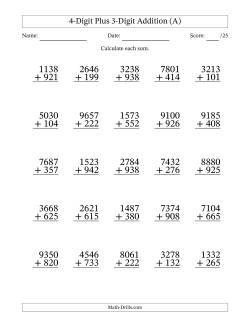
A variety of strategies can be used to learn multi-digit addition; it isn't necessary to rely only on paper and pencil methods. Base ten blocks can help students conceptualize addition. Teaching students a mental left-to-right addition skill will help them in future math studies and life in general. E.g. 34 + 78 would be 30 + 70 = 100, 100 + 4 = 104, 104 + 8 = 112. Don't forget about using estimation with these worksheets.
-
2-Digit plus 1-Digit Addition (25 Questions) ✎ 2-Digit Plus 1-Digit Addition (36 Questions) ✎ 2-Digit plus 1-Digit Addition (64 Questions) ✎ 2-Digit plus 1-Digit Addition (100 Questions) ✎ 2-Digit plus 1-Digit Addition (Sums Less Than 100) (25 Questions) 2-Digit Addition (25 Questions) ✎ 2-Digit Addition (36 Questions) ✎ 2-Digit Addition (64 Questions) ✎ 2-Digit Addition (100 Questions) ✎ 3-Digit Plus 1-Digit Addition (25 Questions) ✎ 3-Digit Plus 1-Digit Addition (36 Questions) ✎ 3-Digit Plus 2-Digit Addition (25 Questions) ✎ 3-Digit Plus 2-Digit Addition (36 Questions) ✎ 3-Digit Plus 2-Digit Addition (49 Questions) ✎ 3-Digit Plus 2-Digit Addition (100 Questions) ✎ 3-Digit Addition (25 Questions) ✎ 3-Digit Addition (36 Questions) ✎ 3-Digit Addition (49 Questions) ✎ 3-Digit Addition (100 Questions) ✎ 4-Digit Plus 1-Digit Addition (25 Questions) ✎ 4-Digit Plus 1-Digit Addition (36 Questions) ✎ 4-Digit Plus 2-Digit Addition (25 Questions) ✎ 4-Digit Plus 2-Digit Addition (36 Questions) ✎ 4-Digit Plus 3-Digit Addition (25 Questions) ✎ 4-Digit Plus 3-Digit Addition (36 Questions) ✎ 4-Digit Plus 3-Digit Addition (49 Questions) ✎ 4-Digit Plus 3-Digit Addition (100 Questions) ✎ 4-Digit Addition (25 Questions) ✎ 4-Digit Addition (36 Questions) ✎ 4-Digit Addition (49 Questions) ✎ 4-Digit Addition (100 Questions) ✎ 5-Digit Addition (25 Questions) ✎ Various 2-digit to 4-digit Addition (25 Questions) ✎ Various 2-Digit to 4-Digit Addition (36 Questions) ✎ Various 2-digit to 5-digit Addition (20 Questions) ✎ Various 2-Digit to 5-Digit Addition (36 Questions) ✎ Various 3-digit to 5-digit Addition (20 Questions) ✎ Various 3-Digit to 5-Digit Addition (36 Questions) ✎ 6-Digit Addition (20 Questions) ✎ 7-Digit Addition (15 Questions) ✎ 8-Digit Addition (15 Questions) ✎ 9-Digit Addition (15 Questions) ✎ 3-Digit Expanded Form Addition
Regrouping is what long addition is all about; these worksheets give students a lot of practice since every step requires regrouping.
-
2-Digit Plus 1-Digit Addition with ALL Regrouping in the Ones Place (25 Questions) ✎ 2-Digit Addition with ALL Regrouping (25 Questions) ✎ 2-Digit Addition with ALL Regrouping (36 Questions) ✎ 3-Digit Addition with ALL Regrouping (25 Questions) ✎ 4-Digit Addition with ALL Regrouping (25 Questions) ✎ 5-Digit Addition with ALL Regrouping (20 Questions) ✎ 6-Digit Addition with ALL Regrouping (20 Questions) ✎ 7-Digit Addition with ALL Regrouping (15 Questions) ✎ 8-Digit Addition with ALL Regrouping (15 Questions) ✎ 9-Digit Addition with ALL Regrouping (15 Questions) ✎
If you haven't quite mastered all the addition facts or the long addition algorithm, these might be the worksheets for you. These worksheets don't require any regrouping, so they provide an extra in-between skill for students who require a little more guidance.
-
2-Digit Plus 1-Digit Addition with NO Regrouping (25 Questions) ✎ 2-Digit Addition with NO Regrouping (25 Questions) ✎ 2-Digit Addition with NO Regrouping (36 Questions) ✎ 2-Digit Addition with NO Regrouping (64 Questions) ✎ 2-Digit Addition with NO Regrouping (100 Questions) ✎ 3-Digit Plus 1-Digit Addition with NO Regrouping (25 Questions) ✎ 3-Digit Plus 2-Digit Addition with NO Regrouping (25 Questions) ✎ 3-Digit Addition with NO Regrouping (25 Questions) ✎ 4-Digit Plus 1-Digit Addition with NO Regrouping (25 Questions) ✎ 4-Digit Plus 2-Digit Addition with NO Regrouping (25 Questions) ✎ 4-Digit Plus 3-Digit Addition with NO Regrouping (25 Questions) ✎ 4-Digit Addition with NO Regrouping (25 Questions) ✎ 5-Digit Addition with NO Regrouping (20 Questions) ✎ 6-Digit Addition with NO Regrouping (20 Questions) ✎ 7-Digit Addition with NO Regrouping (20 Questions) ✎ 8-Digit Addition with NO Regrouping (15 Questions) ✎ 9-Digit Addition with NO Regrouping (15 Questions) ✎
Horizontal addition can encourage students to use mental math or other strategies to add numbers. One of the most common mental math strategies for addition is a left-to-right (also called front end) addition strategy. This involves adding the greater place values first. Other strategies for adding multi-digit numbers include using base ten blocks or other manipulatives, number lines, decomposing numbers and adding the parts, and using a calculator.
-
Adding to 20 with the Second Addend Greater 2-Digit Plus 2-Digit Horizontal Addition with no Regrouping Horizontally Arranged 2-Digit Plus 2-Digit Addition ✎ Horizontally Arranged 3-Digit Plus 2-Digit Addition ✎ Horizontally Arranged 3-Digit Plus 3-Digit Addition ✎ Horizontally Arranged Various 2- and 3-Digit Addition ✎ Horizontally Arranged 4-Digit Plus 3-Digit Addition ✎ Horizontally Arranged 4-Digit Plus 4-Digit Addition ✎ Horizontally Arranged Various 2- to 4-Digit Addition ✎
-
25 Adding 10s Questions ✎ 50 Adding 10s Questions ✎ 50 Adding 11s Questions ✎ 50 Adding 12s Questions ✎ 50 Adding 13s Questions ✎ 50 Adding 14s Questions ✎ 50 Adding 15s Questions ✎ 50 Adding 16s Questions ✎ 50 Adding 17s Questions ✎ 50 Adding 18s Questions ✎ 50 Adding 19s Questions ✎ 50 Adding 20s Questions ✎
Using a comma to separate thousands is the most common way to format large numbers in the English world.
-
Adding 4-Digit Numbers (Comma Separated) (25 Questions) ✎ Adding 5-Digit Numbers (Comma Separated) (20 Questions) ✎ Adding 6-Digit Numbers (Comma Separated) (20 Questions) ✎ Adding 7-Digit Numbers (Comma Separated) (15 Questions) ✎ Adding 8-Digit Numbers (Comma Separated) (15 Questions) ✎ Adding 9-Digit Numbers (Comma Separated) (15 Questions) ✎
-
Adding 4-Digit Numbers with ALL Regrouping (Comma Separated) (25 Questions) ✎ Adding 5-Digit Numbers with ALL Regrouping (Comma Separated) (20 Questions) ✎ Adding 6-Digit Numbers with ALL Regrouping (Comma Separated) (20 Questions) ✎ Adding 7-Digit Numbers with ALL Regrouping (Comma Separated) (15 Questions) ✎ Adding 8-Digit Numbers with ALL Regrouping (Comma Separated) (15 Questions) ✎ Adding 9-Digit Numbers with ALL Regrouping (Comma Separated) (15 Questions) ✎
-
Adding 4-Digit Numbers with NO Regrouping (Comma Separated) (25 Questions) ✎ Adding 5-Digit Numbers with NO Regrouping (Comma Separated) (20 Questions) ✎ Adding 6-Digit Numbers with NO Regrouping (Comma Separated) (20 Questions) ✎ Adding 7-Digit Numbers with NO Regrouping (Comma Separated) (15 Questions) ✎ Adding 8-Digit Numbers with NO Regrouping (Comma Separated) (15 Questions) ✎ Adding 9-Digit Numbers with NO Regrouping (Comma Separated) (15 Questions) ✎
Using a space to separate thousands in large numbers is common in some languages. In the English world, you will most likely find Canadians formatting their numbers in this way.
-
Adding 4-Digit Numbers (Space Separated) (25 Questions) ✎ Adding 5-Digit Numbers (Space Separated) (20 Questions) ✎ Adding 6-Digit Numbers (Space Separated) (20 Questions) ✎ Adding 7-Digit Numbers (Space Separated) (15 Questions) ✎ Adding 8-Digit Numbers (Space Separated) (15 Questions) ✎ Adding 9-Digit Numbers (Space Separated) (15 Questions) ✎
-
Adding 4-Digit Numbers with ALL Regrouping (Space Separated) (25 Questions) ✎ Adding 5-Digit Numbers with ALL Regrouping (Space Separated) (20 Questions) ✎ Adding 6-Digit Numbers with ALL Regrouping (Space Separated) (20 Questions) ✎ Adding 7-Digit Numbers with ALL Regrouping (Space Separated) (15 Questions) ✎ Adding 8-Digit Numbers with ALL Regrouping (Space Separated) (15 Questions) ✎ Adding 9-Digit Numbers with ALL Regrouping (Space Separated) (15 Questions) ✎
-
Adding 4-Digit Numbers with NO Regrouping (Space Separated) (25 Questions) ✎ Adding 5-Digit Numbers with NO Regrouping (Space Separated) (20 Questions) ✎ Adding 6-Digit Numbers with NO Regrouping (Space Separated) (20 Questions) ✎ Adding 7-Digit Numbers with NO Regrouping (Space Separated) (15 Questions) ✎ Adding 8-Digit Numbers with NO Regrouping (Space Separated) (15 Questions) ✎ Adding 9-Digit Numbers with NO Regrouping (Space Separated) (15 Questions) ✎
Using a period as a thousands separator is not generally seen in English-speaking countries, but since there are people from around the world who use these addition worksheets, they are included.
-
Adding 4-Digit Numbers (Period Separated) (25 Questions) ✎ Adding 5-Digit Numbers (Period Separated) (20 Questions) ✎ Adding 6-Digit Numbers (Period Separated) (20 Questions) ✎ Adding 7-Digit Numbers (Period Separated) (15 Questions) ✎ Adding 8-Digit Numbers (Period Separated) (15 Questions) ✎ Adding 9-Digit Numbers (Period Separated) (15 Questions) ✎
-
Adding 4-Digit Numbers with ALL Regrouping (Period Separated) (25 Questions) ✎ Adding 5-Digit Numbers with ALL Regrouping (Period Separated) (20 Questions) ✎ Adding 6-Digit Numbers with ALL Regrouping (Period Separated) (20 Questions) ✎ Adding 7-Digit Numbers with ALL Regrouping (Period Separated) (15 Questions) ✎ Adding 8-Digit Numbers with ALL Regrouping (Period Separated) (15 Questions) ✎ Adding 9-Digit Numbers with ALL Regrouping (Period Separated) (15 Questions) ✎
-
Adding 4-Digit Numbers with NO Regrouping (Period Separated) (25 Questions) ✎ Adding 5-Digit Numbers with NO Regrouping (Period Separated) (20 Questions) ✎ Adding 6-Digit Numbers with NO Regrouping (Period Separated) (20 Questions) ✎ Adding 7-Digit Numbers with NO Regrouping (Period Separated) (15 Questions) ✎ Adding 8-Digit Numbers with NO Regrouping (Period Separated) (15 Questions) ✎ Adding 9-Digit Numbers with NO Regrouping (Period Separated) (15 Questions) ✎
For various reasons, sometimes you need addition questions in a larger font. These should fit the bill.
-
2-digit Plus 1-digit Addition with SOME Regrouping (Large Print) (16 Questions)✎ 3-digit Plus 1-digit Addition with SOME Regrouping (Large Print) (16 Questions)✎ 4-digit Plus 1-digit Addition with SOME Regrouping (Large Print) (16 Questions)✎ Various Plus 1-digit Addition with SOME Regrouping (Large Print) (16 Questions)✎ 2-digit Plus 2-digit Addition with SOME Regrouping (Large Print) (16 Questions)✎ 3-digit Plus 2-digit Addition with SOME Regrouping (Large Print) (16 Questions)✎ 4-digit Plus 2-digit Addition with SOME Regrouping (Large Print) (16 Questions)✎ Various Plus 2-digit Addition with SOME Regrouping (Large Print) (16 Questions)✎ 3-digit Plus 3-digit Addition with SOME Regrouping (Large Print) (16 Questions)✎ 4-digit Plus 3-digit Addition with SOME Regrouping (Large Print) (16 Questions)✎ 4-digit Plus 4-digit Addition with SOME Regrouping (Large Print) (16 Questions)✎ 5-digit Plus 5-digit Addition with SOME Regrouping (Large Print) (12 Questions)✎ 6-digit Plus 6-digit Addition with SOME Regrouping (Large Print) (12 Questions)✎
-
2-Digit Plus 1-Digit Addition with SOME Regrouping (Very Large Print) (9 Questions)✎ 2-Digit Addition with SOME Regrouping (Very Large Print) (9 Questions)✎ 3-Digit Plus 1-Digit Addition with SOME Regrouping (Very Large Print) (9 Questions)✎ 3-Digit Plus 2-Digit Addition with SOME Regrouping (Very Large Print) (9 Questions)✎ 3-Digit Addition with SOME Regrouping (Very Large Print) (9 Questions)✎ 4-Digit Plus 1-Digit Addition with SOME Regrouping (Very Large Print) (9 Questions)✎ 4-Digit Plus 2-Digit Addition with SOME Regrouping (Very Large Print) (9 Questions)✎ 4-Digit Plus 3-Digit Addition with SOME Regrouping (Very Large Print) (9 Questions)✎ 4-Digit Addition with SOME Regrouping (Very Large Print) (9 Questions)✎ Various 2- to 4-Digit Addition with SOME Regrouping (Very Large Print) (9 Questions)✎
-
2-Digit Addition with ALL Regrouping (Large Print) (16 Questions)✎ 3-Digit Addition with ALL Regrouping (Large Print) (16 Questions)✎ 4-Digit Addition with ALL Regrouping (Large Print) (16 Questions)✎ 5-Digit Addition with ALL Regrouping (Large Print) (12 Questions)✎ 6-Digit Addition with ALL Regrouping (Large Print) (12 Questions)✎
-
2-Digit Addition with NO Regrouping (Large Print) (16 Questions)✎ 3-Digit Plus 2-Digit Addition with NO Regrouping (Large Print) (16 Questions)✎ 3-Digit Addition with NO Regrouping (Large Print) (16 Questions)✎ 4-Digit Plus 3-Digit Addition with NO Regrouping (Large Print) (16 Questions)✎ 4-Digit Addition with NO Regrouping (Large Print) (16 Questions)✎ 5-Digit Addition with NO Regrouping (Large Print) (12 Questions)✎ 6-Digit Addition with NO Regrouping (Large Print) (12 Questions)✎ LP 2-Digit Addition with Sums up to 99 (25 Questions) LP 2-Digit Addition with Sums up to 99 (12 Questions)
Multi-Digit Addition with Grid Support
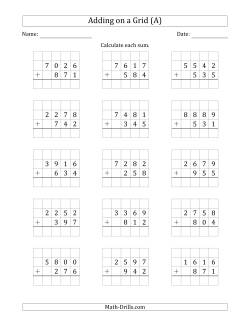
Adding with grid support helps students who have trouble lining up place values themselves. Perhaps with a little practice, they might get a better understanding of not only lining up the place values, but why this is done. Pointing out that the 5 in 659 means 50, for example, is useful in helping students understand place value as it relates to addition.
-
Adding 2-Digit + 2-Digit Numbers on a Grid (2 Addends) Adding 3-Digit + 3-Digit Numbers on a Grid (2 Addends) Adding 3-Digit + 2-Digit Numbers on a Grid (2 Addends) Adding 4-Digit + 4-Digit Numbers on a Grid (2 Addends) Adding 4-Digit + 3-Digit Numbers on a Grid (2 Addends) Adding 4-Digit + 2-Digit Numbers on a Grid (2 Addends) Adding 5-Digit + 5-Digit Numbers on a Grid (2 Addends) Adding 5-Digit + 4-Digit Numbers on a Grid (2 Addends) Adding 5-Digit + 3-Digit Numbers on a Grid (2 Addends) Adding 5-Digit + 2-Digit Numbers on a Grid (2 Addends) Adding Various Digit Numbers on a Grid (2 Addends)
Various Other Addition Worksheets
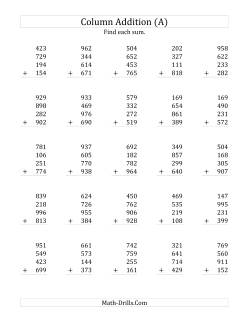
Column addition is not just an exercise in accounting, it also develops mental addition skills that are useful in everyday life. Various strategies are available for adding columns of numbers. The traditional method is to use a pencil and paper approach, also known as right-to-left addition, where students add and regroup starting with the smallest place (ones in this case) and proceed up to the greatest place. A mental approach might involve students going from left-to-right where the greater place is added first. This is easier to keep track of in your head, but does require the occasional adjustment in previous answers. An example is to add 345 + 678 + 901. First add the 300, 600 and 900 to get 1800, then add 40, 70 and 0 in turn to get 1910, then deal with the 5, 8 and 1 to get 1924. Along the way you had to adjust your total, but keeping a running total in your head is a lot easier than transfering a pencil and paper method into your head.
Games help students develop mental addition skills but in a fun context. For the adding with playing cards worksheets, a Jack is counted as 11, a Queen as 12, a King as 13 and an Ace as 1. Playing math games while enjoying some social time with their friends is a great way to develop strategic thinking and math fluency in children.
Finding complements of numbers can help students a great deal in developing mental arithmetic skills and to further their understanding of number.
-
Adding Complements of 9 (Blanks in First or Second Position Mixed) Adding Complements of 9 (Blanks in First then Second Position) Adding Complements of 9 (Blanks in First Position Only) Adding Complements of 9 (Blanks in Second Position Only) Adding Complements of 9 (Blanks in Any Position, Including Sums) Adding Complements of 99 Adding Complements of 999
-
Adding Complements of 11 (Blanks in First or Second Position Mixed) Adding Complements of 11 (Blanks in First then Second Position) Adding Complements of 11 (Blanks in First Position Only) Adding Complements of 11 (Blanks in Second Position Only) Adding Complements of 11 (Blanks in Any Position, Including Sums)
Using an adding doubles strategy can help students to process addition questions more quickly using mental math. To use this strategy, students must recognize that the two numbers are close to the same value (usually by one or two). They also must recognize by how much and whether it is greater or less than the first addend. A typical dialogue with the question, 15 + 16, might be, "I see that the second number is greater than the first number by 1. If I double the first number and add 1, I will get my answer. 15 doubled is 30 plus one is 31. 15 + 16, therefore, is 31."
Not commonly taught in modern schools, adding in other base number systems can stretch students' minds and have quite a few important applications, especially in technology. For example, you will find binary, octal and hexadecimal systems are quite often used in computer technology. Quaternary numbers can be used in genetics to store DNA sequences. The duodecimal system is sometimes suggested as a superior system to the decimal system
-
Adding Binary Numbers (Base 2) Adding Ternary Numbers (Base 3) Adding Quaternary Numbers (Base 4) Adding Quinary Numbers (Base 5) Adding Senary Numbers (Base 6) Adding Octal Numbers (Base 8) Adding Duodecimal Numbers (Base 12) Adding Hexadecimal Numbers (Base 16) Adding Vigesimal Numbers (Base 20) Adding Hexatrigesimal Numbers (Base 36) Adding Various Numbers (Various Bases)